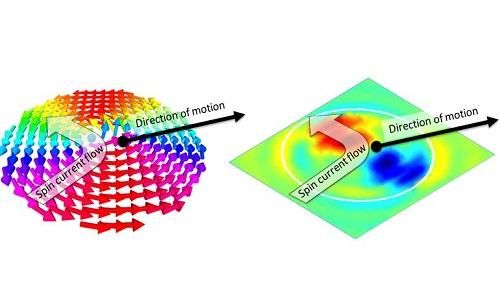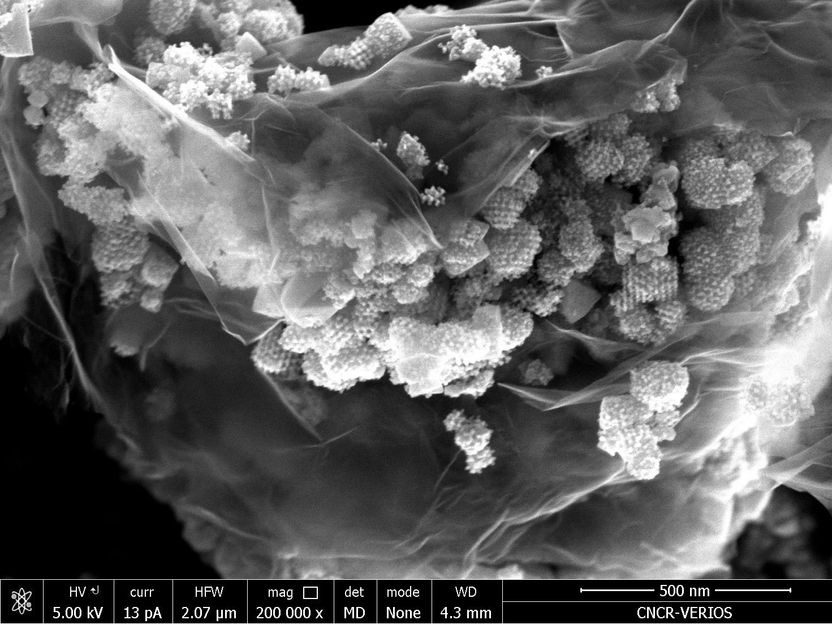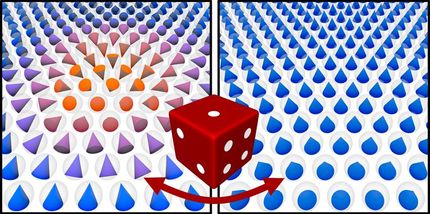Information storage with a nanoscale twist
Swirling objects known as magnetic vortices and skyrmions can be miniaturized without sacrificing mobility, a KAUST-led international research team has found. These findings are relevant for future "race-track" memory technologies that feature massive densities of moveable magnetic bits.

The torque needed to manipulate nanoscale magnetic whirlpools, represented here as red and blue regions with opposite signs, have now been revealed with high-powered synchrotron light.
Reproduced with permission of 2016 American Physical Society
In nanometer-thin magnetic films, such as iron-nickel alloys, the region separating two magnetic domains or defects can adopt tiny whirlpool-like patterns. Some of these patterns, called skyrmions, resist unraveling even when packed tightly together, and they can also be directed with small electric currents. These features have made the skyrmions attractive targets for research into high-capacity memory devices. One concept zips skyrmions around a loop then past a stationary read/write head to eliminate the need for mechanical components used in today's hard drives.
Aurelien Manchon, an Associate Professor of Material Science and Engineering at the University, notes that one of the main reasons for the appeal of skyrmions is their ability to avoid defects or uneven patches in thin films that would normally trap or "pin" a magnetic charge. However, this agility is compromised when researchers try to shrink skyrmions to the smallest size possible--the smaller they get the more likely they are to get pinned because of the relative increase in defect site dimensions.
To improve these devices, Manchon and international collaborators tried to understand the fundamental momentum transfer between charge currents and magnetic whirlpools.
Using intense x-rays generated at Berkeley University's Advanced Light Source, the team captured time-resolved images of whirlpool patterns called magnetic vortices as they gyrated along a nanometer-wide half-ring track. By pinpointing the position of the vortex core from the imaging sequence, they obtained accurate data about a parameter, known as the non-adiabatic spin-transfer torque, which is crucial for electrical manipulations.
Surprisingly, the measured non-adiabatic torque was far greater than values predicted by existing models. To account for this discrepancy, a theoretical analysis by Manchon showed the extra twisting was provided by another force--the emergent Hall effect, which occurs when electrons travel through a magnetic whirlpool.
"In a nutshell, electrons experience a force that pushes them sideways, but it doesn't come from the local magnetization itself; instead it arises from the topology of the magnetic texture," explained Manchon. "This effect produces an extra spin-polarized current that exerts a torque on the whirlpool."
The researchers found that the additional non-adiabatic torque intensifies when the size of the whirlpool is reduced--a driving force that may offer a way to overcome defect pinning at the nanoscale. "This might be an interesting compromise to seek, especially in the context of skyrmion-based data storage," added Manchon.
Original publication
André Bisig, Collins Ashu Akosa, Jung-Hwan Moon, Jan Rhensius, Christoforos Moutafis, Arndt von Bieren, Jakoba Heidler, Gillian Kiliani, Matthias Kammerer, Michael Curcic, Markus Weigand, Tolek Tyliszczak, Bartel Van Waeyenberge, Hermann Stoll, Gisela Schütz, Kyung-Jin Lee, Aurelien Manchon, and Mathias Kläui; "Enhanced Nonadiabaticity in Vortex Cores due to the Emergent Hall Effect"; Phys. Rev. Lett.; 2016
Most read news
Original publication
André Bisig, Collins Ashu Akosa, Jung-Hwan Moon, Jan Rhensius, Christoforos Moutafis, Arndt von Bieren, Jakoba Heidler, Gillian Kiliani, Matthias Kammerer, Michael Curcic, Markus Weigand, Tolek Tyliszczak, Bartel Van Waeyenberge, Hermann Stoll, Gisela Schütz, Kyung-Jin Lee, Aurelien Manchon, and Mathias Kläui; "Enhanced Nonadiabaticity in Vortex Cores due to the Emergent Hall Effect"; Phys. Rev. Lett.; 2016
Topics
Organizations
Other news from the department science

Get the chemical industry in your inbox
By submitting this form you agree that LUMITOS AG will send you the newsletter(s) selected above by email. Your data will not be passed on to third parties. Your data will be stored and processed in accordance with our data protection regulations. LUMITOS may contact you by email for the purpose of advertising or market and opinion surveys. You can revoke your consent at any time without giving reasons to LUMITOS AG, Ernst-Augustin-Str. 2, 12489 Berlin, Germany or by e-mail at revoke@lumitos.com with effect for the future. In addition, each email contains a link to unsubscribe from the corresponding newsletter.
Most read news
More news from our other portals
Last viewed contents
Isotopes_of_sodium
BASF expects record year in 2010 - Third-quarter results significantly above previous year



























































